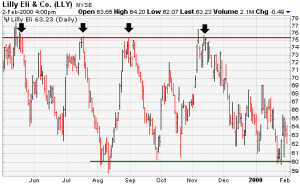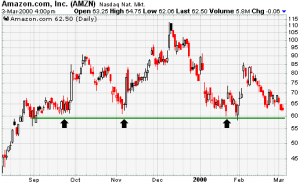Support and resistance represents key junctions where the forces of demand and supply meet. In the financial markets, prices are driven by excessive supply (down) and demand (up).As demand increases, prices advance and as supply increases, prices decline. When supply and demand are equal, prices move sideways as bulls and bears slug it out for control.
What Is Support?
The price level which, historically, a stock has had difficulty falling below. It is thought of as the level at which a lot of buyers tend to enter the stock.
Often referred to as the “support level”.
Support is the price level at which demand is thought to be strong enough to prevent the price from declining further. The logic dictates that as the price declines towards support and gets cheaper, buyers become more inclined to buy and sellers become less inclined to sell. By the time the price reaches the support level, it is believed that demand will overcome supply and prevent the price from falling below support.
Support does not always hold and a break below support signals that the bears have won out over the bulls. A decline below support indicates a new willingness to sell and/or a lack of incentive to buy. Support breaks and new lows signal that sellers have reduced their expectations and are willing sell at even lower prices. In addition, buyers could not be coerced into buying until prices declined below support or below the previous low. Once support is broken, another support level will have to be established at a lower level.
What Is Resistance?
The price at which a stock or market can trade, but not exceed, for a certain period of time.
Often referred to as “resistance level”.
Resistance is the price level at which selling is thought to be strong enough to prevent the price from rising further. The logic dictates that as the price advances towards resistance, sellers become more inclined to sell and buyers become less inclined to buy. By the time the price reaches the resistance level, it is believed that supply will overcome demand and prevent the price from rising above resistance.

Resistance does not always hold and a break above resistance signals that the bulls have won out over the bears. A break above resistance shows a new willingness to buy and/or a lack of incentive to sell. Resistance breaks and new highs indicate buyers have increased their expectations and are willing to buy at even higher prices. In addition, sellers could not be coerced into selling until prices rose above resistance or above the previous high. Once resistance is broken, another resistance level will have to be established at a higher level.
Where Is Resistance Established?
Resistance levels are usually above the current price, but it is not uncommon for a security to trade at or near resistance. In addition, price movements can be volatile and rise above resistance briefly. Sometimes it does not seem logical to consider a resistance level broken if the price closes 1/8 above the established resistance level. For this reason, some traders and investors establish resistance zones.

5200 NILES RANA
shabbash,abhi din me tare giniye
2 ND AUGEST DAY IMPORTNAT FOR AMERICAN GOVT DEBT BUDGET PROGRAMME BE CAREFUL IN INDIAN MARKET? …………………..SELL SELL EVERY RISE ?
i have shorted nifty at level of 5570